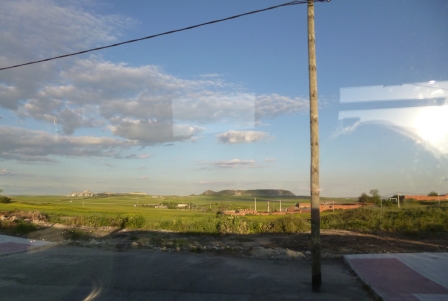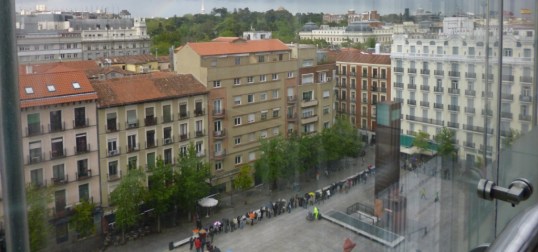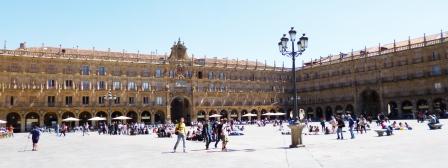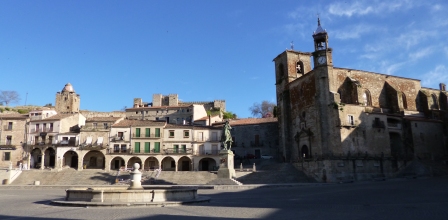Freeway-Free in Spain: It is Good to be the King
 This bright sunny morning was almost too nice to spend inside, even if “inside” is the Palacio Real, home to the monarchs of Spain beginning in the 18th century. We took our time along the way, stopping into a beautiful local market to admire the produce and incidentals on offer.
This bright sunny morning was almost too nice to spend inside, even if “inside” is the Palacio Real, home to the monarchs of Spain beginning in the 18th century. We took our time along the way, stopping into a beautiful local market to admire the produce and incidentals on offer.
At the palace we waited about 10 minutes for entry while being entertained by a guy making giant bubbles and an accordionist playing, inexplicably, “Michele” and “Theme from The Godfather” instead of “Lady of Spain.”
The palace makes Versailles look tawdry. I never imagined so much gold-and-silver-embroidered silk and velvet existed in the world. The extravagance is excused nowadays because the rooms are opened to the public in general for viewing and are otherwise used only for state occasions; the current king prefers to live in more comfort and less pomp in a smaller palace in the suburbs. But still, the amount of wretched excess is a little stomach-turning after viewing the homeless living in cardboard boxes in the arcades of the closed shops in the Plaza Mayor.
The state rooms are, of course, all tapestry, chandeliers, and mirrors, with frescos on the ceilings painted by Tintoretto and Velasquez and other lesser lights. We also got a glimpse of some of the rooms which had been used as private living quarters by various monarchs; these had been decorated to match then-current tastes and ranged from a faux-Tyrolean-beer-hall decor for a billiard room through an all-Chinese porcelain and stucco and tile sitting room to an Empire/Egyptian room with sphinx holding up the table.
A visit to the Royal Armory Museum at the close revealed that the excess had been going on for at least 500 years – a wealth of gilded and engraved armor, including lots of matching miniature armor for the princelings to play in, and elaborate headpieces and breast-plates and rump-covers for the horses, all gilded, lavishly engraved or sculpted, and provided with satin covers and embroidered saddles to finish the look. (None of the kings ever actually fought in these things, although they may have jousted once in a while.)
After leaving the Palacio we took refuge in Taberna de Alabardero, an al fresco stree-tside cafe recommended by Lonely Planet AND Rick Steves, overlooking the palace and gardens. The prices were high and the service slow, but the people-watching was prime.
We finished off the afternoon with a stroll in the Royal Gardens and the Campo del Moro, then caught the Metro back to the hotel. For the evening we enjoyed a gala dinner at nearby Tres Encinas, a rather upscale (for us) seafood restaurant nearby. I seized the opportunity to wear my one “nice” outfit, just so I can say the suitcase space wasn’t wasted.
Our maitre’d was unabashedly charmed by Winifred’s Peruvian-accented Spanish, and monitored our table closely as we divided a wonderful salad of grilled vegetables and prawns (with heads and legs still attached to show how fresh they were) followed by a sole in the same state for the same reason but expertly divided and de-boned, followed by a dessert of chocolate brownie plus trimmings, and a couple of complimentary cuplets of cherry liqueur as a gift of the host. We were very glad we had dressed for the occasion!












































